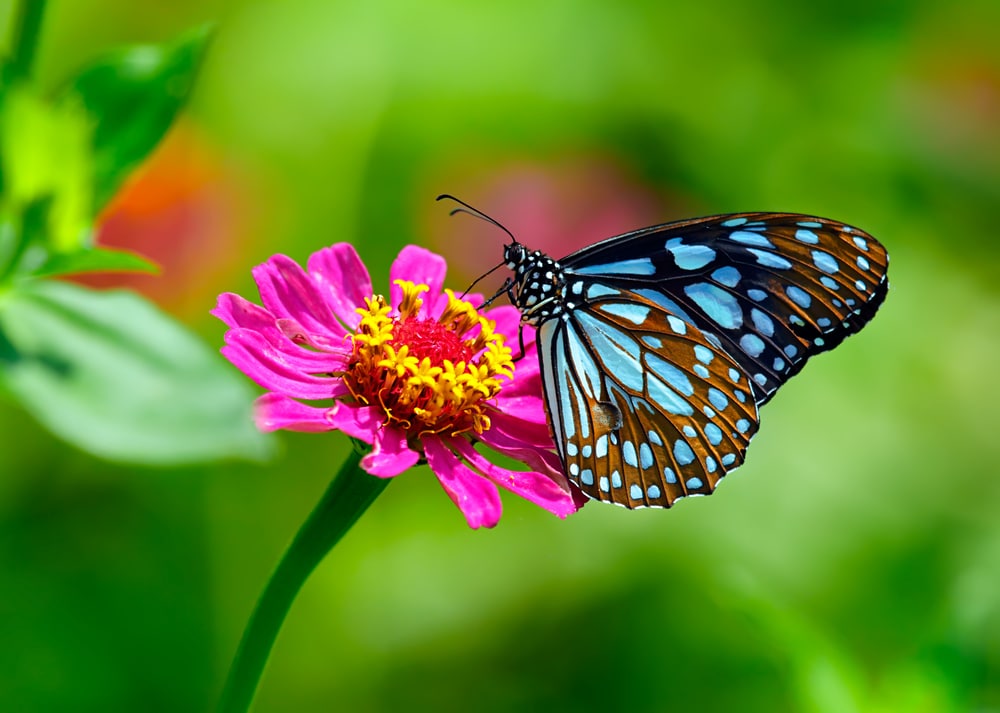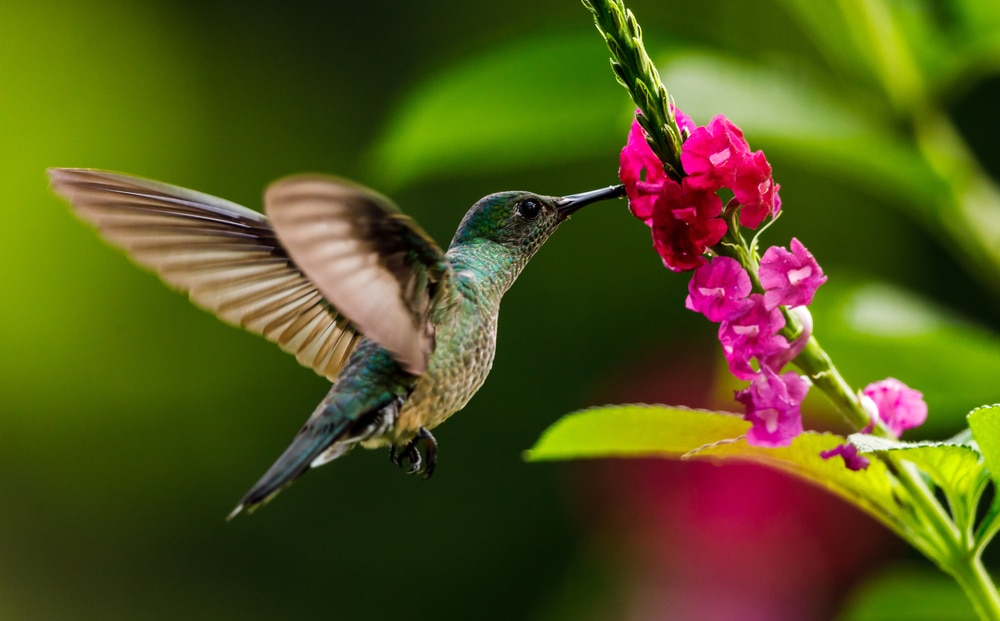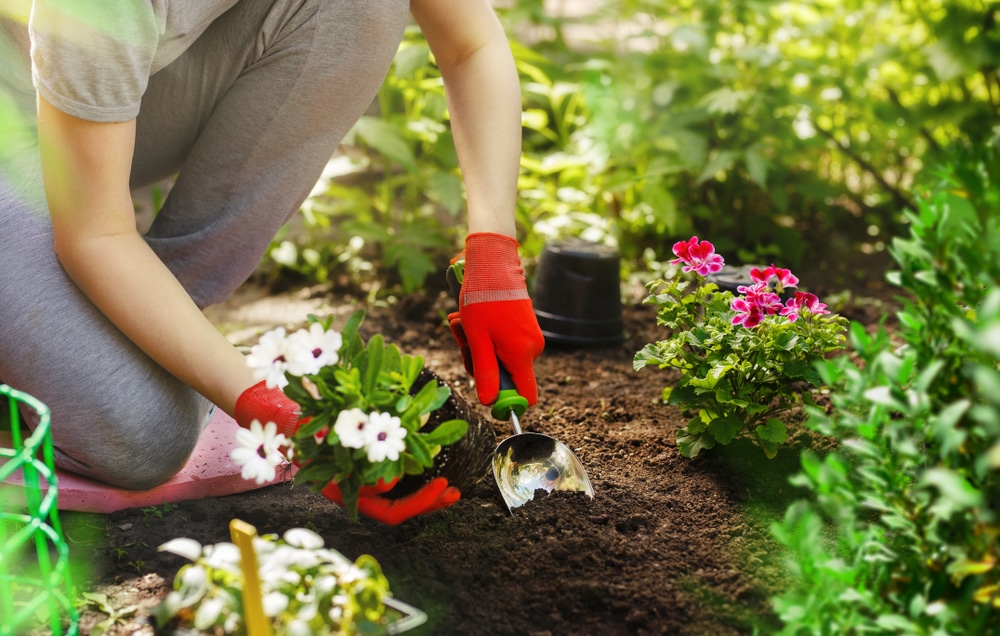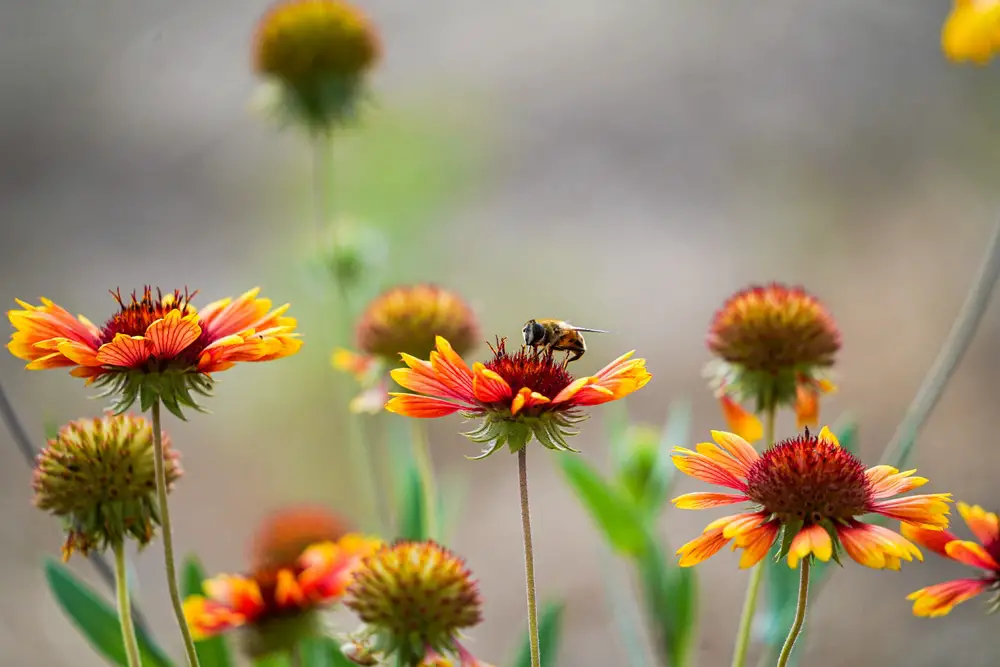Pollinators are vital. They ensure the successful reproduction of a massive amount of our crop species and thousands of wildflowers. If you want to make your garden thrive, then attracting pollinators is one of the best ways to do this. But just what are the best pollinators for your garden?
The best pollinators for your garden are bees, butterflies, moths, hummingbirds, bats, and parasitic wasps. Attracting them requires planting flowers they like, providing them with water, creating sites for them to nest, leaving some unmown grass, and eliminating harsh chemical use.
What Are Pollinators And Why Are They Important?

Pollination occurs when the stamen (the male part of a plant) makes pollen, which makes its way to the stigma (the female part of a plant). 25% of all flowering plants do this by themselves.
But what about the remaining 75% of flowering plant species?
These rely on pollinators, insects, animals (and even the wind and water) that transfer pollen from one plant to another (within the same species).
Some pollen attaches to the pollinators as they feed on these flowers’ nectar. They drop it off when they move to another flower. The pollen that reaches the stigma begins that plant’s reproductive process, resulting in fruit and seeds.
Pollination is the name of the above process. Without it, many plant species would cease to exist, and many more would struggle. This includes wildflowers and crops, meaning a reduction in the foods available to us. In addition, the loss of any plants would hurt the quality of our air and the stability of our soil.
Best Pollinators And What Plants Attract Them

There are around 350,000 pollinator species worldwide, many of which are regular visitors to your garden. However, they’ll only come if the habitat is suitable, so it’s crucial to provide them with native flowering plants.
These are the best pollinators among those, and these are the plants to attract them.
Bees
Bees are probably the first creatures you think of when someone asks you to name a pollinator. But did you know that there are around 20,000 different species?
Which bees you encounter in your garden largely depends on your location. For example, there are around 3,600 species in North America and about 270 species native to the United Kingdom.
Of all bee species, the honeybee is one of the most well-known. This species lives in large colonies, numbering up to 60,000. They pollinate crops such as apples, almonds, cucumbers, watermelons, and avocados, among others.
But they’re also vital to the survival of many garden plants. Try planting things like sunflowers, coneflowers, lavender, goldenrod, and rosemary if you’re trying to attract them.
In fact, bees are so important for plants, especially when you consider that honey bees alone are responsible for pollinating up to 80% of all human crops, which is around 130 different veggies and fruits!
Butterflies
Butterflies are incredibly efficient pollinators and stunning to look at. Having an abundance of butterflies in your garden is a great way to encourage pollination and see nature’s beauty.
There are about 17,500 species of butterflies. As with bees, what types visit your garden depends on where you are.
For example, in North America, you might spot species like the red admiral, the monarch, or the painted lady. In the UK, you can see the swallowtail and brimstone butterflies, while in Asia, you can see the Chinese map butterfly, the purple emperor, or the Mandarin swallowtail.
Different flowering plants attract different butterflies, so try planting species such as the butterfly bush, asters, zinnia, or milkweed.
While bees are often seen as the most important crop pollinators, butterflies also play an essential role. Non-bee pollinators, such as butterflies and beetles, are responsible for the pollination of up to 38% of all crops.
Moths
Not all flowering plants bloom during the day. Some flower species bloom in the late afternoon or even at night. They rely on nocturnal pollinators, and moths are one of the most effective.
There are approximately 160,000 species of moths, many more than their cousins, the butterflies. Moths are primarily attracted to very fragrant and usually white or pale flowers.
People previously thought moths were not as effective as other pollinators, but a study by University College London proved otherwise. This study showed moths may be much more effective than we once thought because they have hairs on their underbellies perfect for pollen to stick to.
While moths only account for around 15% of all visits to pollen plants, studies have shown they can perform the process much more rapidly than insects like bees.
You can grow several plants in your garden to attract moths, such as honeysuckle, evening primrose, flowering tobacco, and moonflower. However, certain moths are effective at pollinating plants within the yucca family.
Moths from the Tegeticula and Parategeticula groups may intentionally pollinate yucca plants they used to mate in. They’ll use the same plants to lay their eggs. But it isn’t just the moths benefitting from this mutual relationship. Some yucca species rely solely on these moths for pollination so they can also reproduce.
Hummingbirds
No species of pollinating bird is more famous than the hummingbird. In fact, according to the Audubon Society, these tiny birds are essential in pollinating more than 8,000 plants in North America alone.
You can easily recognize a hummingbird by their long bills, which they use to extract nectar from deep within the flower. This is the main part of their diet, and they may consume half their body weight in nectar, feeding every ten to fifteen minutes!
As they feed on nectar, pollen sticks to the hummingbirds, which they transfer to the next flower they visit.
If you want to attract these tiny but beautiful birds to your garden, you’ll need to plant flowers like cardinal flowers, butterfly bushes, petunias, and trumpet honeysuckles. These birds also love lupine, coral bells, and foxglove.
Bats
Bats may not instantly come to mind when you think of pollinators, but what most people aren’t aware of is that they’re responsible for pollinating up to 500 different crop species!
These crops include mangoes, guava, banana, and even agave, used to make tequila.
Like moths, bats are nocturnal and take over the work of diurnal species for nighttime pollination. Moreover, inviting bats into your garden can be a viable pest control method.
There are around 1,400 different species of bats, but they mainly pollinate in tropical areas. You may find them in North America in Florida, and they’re great to have around your garden.
However, as with many wild animals, there is a potential of contracting diseases from bats. These cute nocturnal pollinators are long-term carriers of diseases like ebola, rabies, and coronavirus.
While the risk of infection is low, it’s important to avoid handling bats where possible. If you must handle a bat (perhaps when helping an injured animal, although we recommend calling animal control), always wear gloves and a face covering, and wash your hands thoroughly afterward.
If a bat bites you, the CDC recommends trying to capture the bat so medical staff can test for diseases such as rabies. This will enable medical staff to provide you with the proper treatment.
Moreover, bat poop, known as guano, can contain spores. If a person breathes in these sports, it can result in histoplasmosis. This disease may come with mild symptoms for humans but can also be fatal. For this reason, when cleaning a bat box, wearing protective gear such as gloves and a face covering is vital.
But it’s not all bad news with bats. Not only will bats pollinate plants like evening primrose, goldenrod, moonflower, and night-scented stock, but their poop (known as guano) is an excellent natural fertilizer.
Parasitic Wasps
If you’re anything like me, you’ll try to avoid wasp species like the yellow jacket, as they’re known for their aggressive nature and nasty sting. However, these and many other parasitic wasp species are crucial pollinators.
These wasps differ from regular wasps as they lay their eggs inside or on a host, such as a caterpillar. Parasitic wasps flock to flowering plants because of the nectar. While collecting this, they also inadvertently collect pollen. Species such as Queen Anne’s lace, sweet fennel, and boneset are all excellent for attracting wasps.
Wasps also eat scale insects, flies, aphids, and other garden pests. So, while you might want to observe them from a distance, there’s no denying they’re essential to the health of your garden.
How Can I Attract Pollinators To My Garden?

I’m super keen to attract pollinators to my garden as this benefits myself and the pollinators I’m attracting. By providing a suitable habitat for these amazing creatures, you’re encouraging pollination and ensuring our pollinators can thrive and continue doing what they do best.
With that in mind, I researched the best ways to attract pollinators. I found some beneficial information that I’ve put into action in my backyard.
Plant Native Plants
Planting native plants is one of the best things you can do to attract pollinators. The reason is that pollinators, like bees, are more attracted to native plants than exotic ones.
Moreover, native plants are perfectly adapted to the growing conditions in your garden. The benefit of this is that they thrive much more easily.
However, when choosing plants, I would advise planting a selection of different species and colors, as this will bring in the most diversity in terms of pollinators. Selecting plants with different blooming periods is also a good idea to encourage year-round pollination.
Provide A Water Source
Just like you and I, pollinators need water to drink. Even a small water source in your garden is an excellent way to attract these insects and animals.
While many people may choose a wildlife pond or ornate water feature, something as simple as a dish of water or a wet patch under the hose can be just as beneficial.
To make the water dish for insects, get a shallow container and fill it with sand or soil. Pour water in until it’s only a couple of centimeters above the surface. This gives insects a safe way to drink.
Create Nesting Sites
All pollinators need somewhere to lay eggs and raise their young, so providing them with the space to do this is essential.
For bees and wasps, drill holes into wood or provide them with an insect hotel.
For bats, provide them with a bat box.
If you want to attract butterflies to your garden, planting host plants (where they lay their eggs) helps. For example, milkweed is a host plant for monarch butterflies.
Leave Some Bare Soil
For ground-nesting species such as bumble bees, ground-nesting species such as bumblebees need access to soil. I’m not suggesting you leave a vast expanse of bare soil, but just a few small patches can be enough to attract these creatures.
While mulch benefits the soil (which it is), using too much can block access for ground-nesting species. I’d therefore suggest only applying this where it’s necessary.
Leave Some Unmown Grass
One of the most significant changes I have recently made in my garden is leaving a strip of unmown grass along one side. I’ve allowed around 18 inches wide and 10 feet long of wild grass, providing shelter and shade for pollinators.
Moreover, many pollinators also feed on bugs, so having a patch of wild grass provides them with the perfect hunting spot. Not to mention these areas will soon fill up with wildflowers, which provide a valuable nectar source for pollinators.
With that said, I have heard some people saying this could look untidy. I’ve positioned my unmown area along a fence that people can only see from within my garden. So, there are no concerns from my neighbors about things being unsightly.
However, I personally love the way this area looks. You don’t want to let it grow so out of control that it becomes an eyesore, and you’ll need to check local ordinances to ensure you’re not breaking any rules. But having a little wild grass gives that part of the garden a woodland feel.
Reduce Pesticides And Other Garden Chemicals
While you can do everything in your power to attract pollinators, using chemicals in your garden will mean it’s all in vain.
Pesticides can cause serious developmental damage in bees and compromise their immune responses.
Eradicating pesticides in your garden can make a world of difference for pollinators and provide them with a safe habitat to forage and nest.
Can Anyone Attract Pollinators?
Yes! It doesn’t matter where you live or how much space you have in your garden. There are always things you can do to attract pollinators.
You can do it even if you don’t have a garden, so long as you have a small terrace or balcony. You can place potted native plants and a small water source there.
Every little bit helps!
How Hard Is It To Attract Pollinators?
It’s incredibly easy to attract pollinators to your garden. By following the tips I’ve provided, you’ll notice a vast increase in the number of species visiting your space.
I can personally vouch for this as I’ve recently taken the initiative to invite pollinators to my garden. Before I did this, it was rare that I’d see butterflies, bees, and bats in my garden.
But now I’ve made some small changes, like growing a wild patch of lawn, including native plants, and having a water source, I’ve noticed many more pollinating visitors. Plus, it all happened very quickly.
How Long Does It Take To Attract Pollinators?
During the height of spring and summer, when most plants are ready for pollination, creating a pollinator-friendly garden will yield speedy results.
Within just a few days to a week, I noticed a significant increase in bees and butterflies entering my garden. After a few months, my garden was bursting with pollinators, and it’s wonderful to observe them going about their business.
Will Pollinators Return Season After Season?
Pollinators will keep coming back as long as you continue to provide a suitable environment for pollinators.
That said, it’s worth considering many pollinators hibernate during winter. Bees, for example, remain in the hive or nest during the colder months, typically emerging when the weather warms up in spring.
In northern areas, hummingbirds return between April and May as the weather improves. However, they’ll head south for the winter around August or September once their breeding season ends.
If you’re looking to attract bats, keep in mind they also hibernate or enter a state of torpor (inactivity) during the winter. Depending on the weather, they’ll start to emerge again from late March to early May.
Are There Pollinators Other Than Insects?
There are plenty of pollinators other than insects. These include (but are not limited to) the following:
- Birds
- Bats
- Bears
- Lemurs
- Rabbits
- Honey possums
- Geckos
- Skinks
- And even the wind and water (rain)
Final Thoughts
Attracting pollinators to your garden is a great way to ensure it thrives. But you’re also benefiting the pollinators as you’ll provide them with a fantastic habitat to nest and forage.
The survival of some of our favorite crops and plants depends on pollination as well, so it’s vital we all do our bit to protect these beloved species. Taking even one step can have a significant impact in this way.

